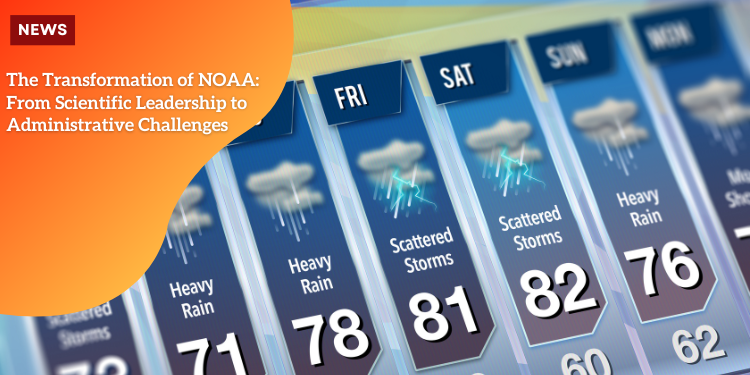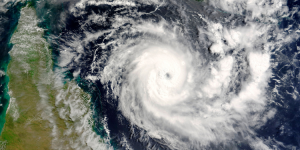The Transformation of NOAA: From Scientific Leadership to Administrative Challenges

Introduction: NOAA’s Shifting Mission
Overview of NOAA’s Traditional Scientific Mission and Importance to the Nation
The National Oceanic and Atmospheric Administration (NOAA) has long been a cornerstone of scientific research and environmental stewardship in the United States.
Established to understand and predict changes in climate, weather, oceans, and coasts, NOAA’s mission is crucial for protecting life and property, preserving natural resources, and enhancing the nation’s economy.
The agency plays a vital role in providing timely and accurate weather forecasts, conducting oceanographic research, and managing marine resources, directly impacting sectors from agriculture to fisheries and disaster preparedness.
Introduction to the Current Claims That the Agency Has Been Set on a “Non-Science Trajectory”
Recently, there have been alarming claims that NOAA’s mission is being derailed.
Reports suggest that the agency has been nudged onto a “non-science trajectory,” as significant cuts and organizational changes undermine its foundational mission.
According to NOAA employees, administrative decisions have drastically reduced the agency’s capacity to perform its scientific functions, leading to fears of substantial long-term damage to ongoing and future research efforts.
Brief Explanation of Why These Changes Matter to Everyday Americans
These changes have far-reaching implications for everyday Americans. NOAA’s ability to collect and analyze climate and weather data is critical for everything from daily weather forecasts to long-term climate projections.
This information is vital for making informed decisions about community planning, agriculture, and natural disaster preparedness.
Moreover, NOAA’s work in managing fisheries ensures sustainable seafood resources and the health of marine ecosystems.
The potential degradation of air and water quality as a result of these changes could directly affect public health.
Without rigorous scientific oversight and research, the U.S. could face significant environmental and economic challenges, highlighting the urgency of addressing these administrative shifts.
These are not abstract issues; they touch the very fabric of everyday life, underscoring the importance of maintaining NOAA’s scientific integrity and capacity.
| Scenario | Before | After (Impact of Administrative Changes) |
|---|---|---|
| 🔬 Staff | Large team of engineers and scientists | Reduction of over 6,700 staff members |
| ⚠️ Job Stability | Stable positions with long-term career prospects | Firing-reinstatement-refiring cycle creates instability |
| 💼 Staff Morale | High morale with engaged and experienced staff | Low morale due to fear of job instability |
| 👨🔬 Expertise | Experienced professionals with specialized knowledge | Severe expertise gaps due to early retirements and resignations |
| 📊 Research & Operations | Ongoing scientific research and data collection | Abandoned research projects and interrupted operations |
Impact on Scientific Research and Data Collection
Disruption of Critical Data Collection
The restructuring of NOAA has significantly disrupted essential data collection efforts, with the firing of over 6,700 engineers and scientists.
This upheaval has especially affected NOAA’s ability to record global temperatures, both in the air and oceans.
These data sets are critical for tracking climate change trends and informing environmental policies.
Threats to the Oceanic and Atmospheric Research (OAR) Office
The Oceanic and Atmospheric Research (OAR) office, a cornerstone of NOAA’s scientific efforts, faces severe threats due to administrative actions aimed at its abolition.
The reduction in research personnel leaves glaring gaps in expertise, compromising the continuity and reliability of ongoing projects.
According to a NOAA veteran, these projects include advancements in sustainable fisheries management and disaster preparedness, key areas where scientific oversight is irreplaceable.

Long-Term Consequences of Interrupted Scientific Data Series
The long-term consequences of these disruptions are profound. Scientific data series, essential for longitudinal studies, are now in jeopardy.
Interruptions mean that trends and changes may go unnoticed, hindering the development of effective mitigation strategies.
The lack of consistent data directly affects NOAA’s capacity to forecast and respond to environmental phenomena, impacting public policy and safety.
As we dive deeper into the cascading effects of these changes, we’ll explore further how NOAA’s reduced scientific capacity hampers critical environmental and public health initiatives.
Environmental and Public Health Implications
Potential Degradation of Air and Water Quality
NOAA scientists have raised alarms about the environmental impacts resulting from the agency’s drastic budget cuts and restructuring.
With a significant reduction in scientific personnel, the capacity to monitor and improve air and water quality is severely compromised.
One NOAA researcher cautioned, “We still have harmful algal blooms, we still have fisheries that are collapsing, waters you can’t swim in.
These problems don’t go away because we fired all the people who were trying to solve a problem”.
Reductions have left NOAA scrambling to keep up with essential environmental monitoring, risking significant degradation of air and water quality across the nation.
Harmful Algal Blooms and Fisheries Collapse
The agency’s reduced capacity to tackle harmful algal blooms, which can poison marine life and disrupt local economies, poses a dire threat to public health and the environment.
The collapse of fisheries due to inadequate scientific oversight further exacerbates these issues.
These environmental threats do not just remain in the ocean; they come ashore, impacting human health and local economies as well.
Connections to Public Health
There is a direct link between NOAA’s scientific research and public health outcomes.
Clean water and breathable air are fundamental to the wellbeing of every American.
The potential inability to achieve this results from systematic dismantling of NOAA’s capabilities.
This, in turn, can lead to elevated risks of respiratory conditions, waterborne illnesses, and a general decline in life quality.
The implications of these changes extend beyond environmental degradation;
they threaten the very health and safety of the population, highlighting the importance of a robust and scientifically driven NOAA to tackle such critical issues.
Changes in Leadership and Decision-Making
Installation of Political Appointees
There has been a significant shake-up in NOAA’s leadership, with political appointees being placed in key positions.
These appointments are viewed by many within the agency as a deviation from its traditionally science-driven mission.
For instance, political appointees installed during the Trump administration have taken command over various critical segments of NOAA.
This shift has raised concerns about whether the new leadership possesses the necessary scientific credentials to effectively manage the agency.
Shift in Contract Review Processes
Another key change involves the review processes for contracts within NOAA, now heavily influenced by the Department of Government Efficiency (DOGE).
This department has been tasked with scrutinizing NOAA contracts, which has led to delays and cancellations of essential research projects.
This bureaucratic shift has further strained NOAA’s operational efficiency and raised transparency concerns.
According to reports, all contracts over $100,000 must be approved by the Trump-appointed Department of Commerce Secretary, Howard Lutnick.
Concerns About Leadership Qualifications
The qualifications of NOAA’s new leadership, compared to seasoned scientific experts, has been a point of contention.
Critics argue that these political appointees lack the necessary scientific training and understanding to lead such a complex scientific agency.
This sentiment is echoed by NOAA employees who have expressed frustration over the “non-science trajectory” of their mission, which they claim is stifling efforts to address urgent environmental issues.
As these leadership changes continue to unfold, they have created an atmosphere of uncertainty and demoralization among NOAA’s staff.
This context sets the stage for examining how these administrative adjustments are impacting the agency’s ability to fulfill its scientific and environmental mandates.
Budget Cuts and Operational Impacts
Examination of Funding Cuts
The National Oceanic and Atmospheric Administration (NOAA) has endured significant budget cuts that threaten its capacity to perform crucial research and provide essential services.
These cuts have particularly affected regional climate centers and university partnerships, which are vital for conducting localized climate analysis and developing the next generation of environmental science leaders.
Funding cuts have forced the closure of four regional climate centers, leaving only two to cover the entire United States, with a funding lapse pending in June.
Moreover, nearly $4 million in funding intended for a cooperative agreement with Princeton University was abruptly halted, directly undermining collaborative research efforts that inform climate policy and environmental management.
Such drastic reductions in financial support are not merely administrative hiccups; they jeopardize the infrastructure and collaborative networks essential for the advancement of environmental science.
Reduced Capacity for Disaster Preparation and Response
The budget cuts have also critically weakened NOAA’s ability to prepare for and respond to environmental disasters.
Resources previously allocated for disaster preparedness are now stretched thin, leaving the agency unable to fully support local and state efforts in the face of hurricanes, wildfires, and other natural calamities.
The decommissioning of critical data services on earthquakes, marine, coastal, and estuary science exacerbates this problem, as timely and accurate data are essential for effective disaster response.
This reduced capacity means that NOAA can no longer offer the same level of support that was once instrumental in averting and mitigating the impacts of disasters.
Communities that rely on NOAA’s data and expertise for emergency planning and recovery are left more vulnerable to the escalating frequency and severity of natural disasters, which are intensified by climate change.
Decommissioning of Data Services and Research Infrastructure
The decommissioning of 14 NOAA data services marks a severe blow to the scientific community’s ability to monitor and analyze environmental changes.
These services, which include essential data on earthquakes, marine systems, and coastal and estuary environments, have been a backbone for many research initiatives.
Without them, the collection and continuity of critical environmental data are disrupted, leading to gaps that can hinder long-term scientific understanding and informed policymaking.
This dismantling of research infrastructure impedes NOAA’s mission to observe and predict changes in the Earth’s environment.
The loss of these services means that scientists cannot access the data necessary for tracking trends and making accurate forecasts, which affects everything from daily weather predictions to long-term climate models.
As NOAA grapples with these challenges, the next chapter will delve into the dilemmas faced by NOAA in implementing the Endangered Species Act for marine life, highlighting the regulatory implications of reduced scientific capacity and the impact on species recovery efforts.
The Endangered Species Dilemma
NOAA’s Role in the Endangered Species Act
NOAA plays a critical role in the implementation of the Endangered Species Act, particularly for marine life.
Its efforts are key to identifying endangered species, monitoring their populations, and developing recovery plans.
This scientific work requires substantial expertise and resources, enabling NOAA to provide accurate and relevant data for regulatory decisions.
Impact of Staff Reductions on Species Identification and Recovery Efforts
The sweeping staff reductions at NOAA have had a devastating impact on its ability to fulfill these vital functions.
Over 6,700 scientists and engineers have been removed, leading to significant expertise gaps in the agency.
The loss of staff has left many scientific research teams struggling to maintain productivity, with gaps in critical areas of specialty.
Remaining scientists are often forced to scramble to find workarounds to continue their efforts, leaving recovery plans for endangered species in jeopardy.
Early retirements and resignations have exacerbated these problems by creating further knowledge gaps.
The cumulative effect of these reductions has led to a situation where scientists are stretched thin, compromising the quality and thoroughness of their work on species recovery.
Potential Regulatory Implications
Reduced scientific capacity at NOAA poses significant risks for the implementation of regulations protecting endangered species.
Without enough experts to conduct thorough research and provide accurate data, regulatory decisions may become less effective or timely.
This shortfall can undermine enforcement actions, potentially leading to weaker protections for vulnerable species.
Additionally, the systematic dismantling of scientific teams responsible for enforcing the Endangered Species Act indirectly aids those advocating for deregulation.
By eliminating the scientists who support these critical protections, NOAA becomes less capable of effectively implementing the law, allowing for heightened risks to marine life and biodiversity.
These administrative changes leave a concerning gap that threatens to undermine decades of conservation efforts.
The result is a landscape where the identification and recovery of endangered species are far more challenging, potentially leading to irreversible losses in marine biodiversity.
As NOAA navigates these tumultuous changes, the agency’s ability to sustain its mission and preserve America’s natural heritage remains at the forefront of concern.
Worker Perspectives and Morale Issues
First-hand Accounts from NOAA Employees
The transformation at NOAA has elicited strong responses from current and former employees, highlighting significant challenges.
One NOAA veteran voiced their frustration, “Pretending that our resources are inexhaustible doesn’t make them inexhaustible”.
This sentiment is echoed by many within the agency who feel that the disregard for scientific expertise is leading to serious repercussions.
Worsening Workplace Morale
A recurring theme in employee accounts is the profound effect of administrative changes on morale.
Staff reductions, particularly the firing of over 6,700 scientists and engineers, have left teams struggling to fill expertise gaps.
According to a longtime research scientist who took early retirement, “I left because it was just so demoralizing and fearful and scary”.
Such demoralization has a direct impact on productivity, with remaining employees stretched thin and unable to maintain the quality of their scientific work.
Challenges in Maintaining Mission Focus
The chaotic administrative environment has made maintaining NOAA’s mission increasingly difficult.
The controversial cycle of firing-reinstatement-refiring of probationary employees further disrupts workflow, making it almost impossible for teams to operate smoothly
. Rachel Brittin, former federal deputy director of external affairs, explained, “The whole situation is a mess… The loss of anybody at NOAA is directly connected to services lost by every individual in the United States”.
Amid these challenges, the critical functions NOAA performs are at risk. Workers describe a sentiment of “just letting it burn,” indicating a belief that the systematic dismantling of the agency is deliberate and possibly irreversible.
This precarious situation sets the stage for NOAA’s future and its ability to recover its scientific leadership and fulfill its mandate effectively.
The Future of American Scientific Leadership
Long-term implications for U.S. leadership in climate and ocean science
NOAA’s recent downsizing and strategic shifts carry long-term consequences for U.S. leadership in climate and ocean science.
The firing of over 6,700 scientists and engineers leaves an immense gap in scientific expertise, affecting NOAA’s ability to conduct world-class research.
Lack of continuity in data collection hinders long-term climate studies and environmental monitoring that many countries depend on.
Potential recovery paths and what would be needed to restore scientific capacity
Restoring NOAA’s scientific capacity requires rebuilding its workforce and recommitting to its foundational mission.
This means:
- Rehiring experienced scientists and engineers.
- Investing in new talent and advanced research projects.
- Encouraging collaboration with academic institutions and international research bodies.
A dedicated effort to secure long-term funding and revert recent administrative changes is also crucial.
This approach can rejuvenate NOAA’s role and restore its capacity to provide critical environmental insights.
Comparison to other nations’ approaches to environmental science agencies
Other nations, like Canada and Germany, maintain robust environmental science agencies by prioritizing stable funding and scientific independence.
For example, Environment and Climate Change Canada (ECCC) has been steadfast in preserving its scientific workforce and securing cross-party support for its initiatives.
Similarly, the German Environment Agency (UBA) is well-resourced and benefits from continuous governmental backing.
If the U.S. is to regain its position as a leader in environmental science, learning from these models and prioritizing scientific over political priorities is essential.
Such measures can reinforce NOAA’s capabilities and ensure that it continues to contribute valuable global environmental insights.
Returning to a science-driven trajectory not only revitalizes NOAA but also safeguards public health and environmental stability, ensuring a better future for all Americans.
Conclusion: What’s at Stake
The transformation of NOAA’s mission carries significant implications for everyday Americans.
As an agency responsible for critical environmental and scientific services, NOAA’s effectiveness directly impacts our quality of life.
The dismantling of its scientific capacity jeopardizes essential functions such as climate change monitoring, disaster preparedness, and the protection of marine ecosystems.
Connection Between Scientific Research and Practical Outcomes
NOAA’s scientific work translates into tangible benefits like clean air and water, accurate weather forecasts, and sustainable fisheries.
Without robust data collection and research, our ability to make informed decisions on environmental policies is crippled.
For instance, the degradation of air and water quality can lead to increased health problems, making it evident that NOAA’s mission is vital to public health.
Rebuilding Scientific Institutions
Restoring NOAA’s scientific integrity will not be an easy task.
It involves rehiring experienced staff, investing in new talent, and ensuring that scientific research remains apolitical.
Learning from countries like Canada and Germany, where stable funding and scientific independence are prioritized, can offer valuable insights into rebuilding NOAA’s capacity.
The challenge lies in not only addressing the immediate gaps but also fostering a culture where scientific evidence drives policy decisions.
The ongoing administrative changes within NOAA highlight a pressing need to recognize and reverse the damage to maintain America’s leadership in environmental science.






